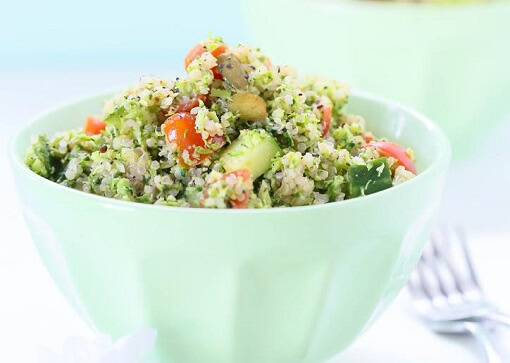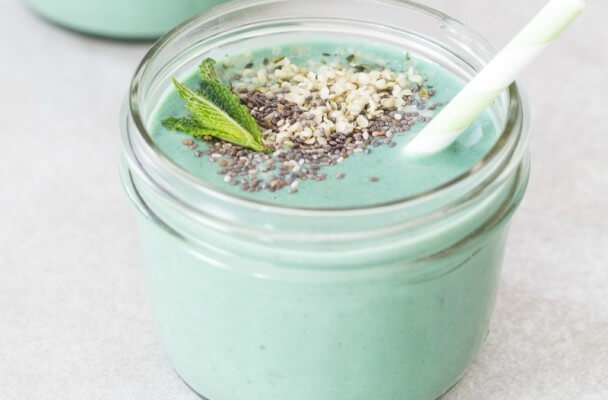Sources of Omega-3 and Omega 6 Fatty Acids
Fats get a bad rap in our society. In the 1960s, physicians began to promote low-fat diets as a way to reduce heart disease and cholesterol levels (La Berge, 2008). By the 1980s, the federal government, food industry, and media waged an all-out war against fats. Ironically, Americans got fatter than ever during this period. Now, the pendulum has begun to swing the other way as scientists recognize the beneficial health effects of certain fats. The important thing is to emphasize consumption of certain forms of healthy fats while avoiding unhealthy fats in your diet.
Types of Fats
There are four main types of fats found in our diets: saturated, trans, polyunsaturated, and monounsaturated. As a class, fats refer to molecules that have a particular chemical structure. The number of double bonds between components of the molecule determine the type of fat. Monounsaturated and polyunsaturated fats contain more double bonds, which affects their overall structure.
Not only do different fats have different structural configurations, but they also affect human health differently. For example, trans fats and saturated fats are associated with higher levels of “bad” LDL cholesterol. This increases risk of cardiovascular disease. In contrast, monounsaturated and polyunsaturated are considered healthy fats. Boosting these fats in your diet increases levels of “good” HDL cholesterol and lowers cardiovascular risk.
Omega-3 vs. Omega-6 Fatty Acids
Omega-3 and omega-6 fatty acids are essential fats, meaning that your body cannot produce them on its own. Thus, you must get these fats from your diet to remain healthy. These fatty acids form part of the phospholipid bilayer, which, in turn, forms the cell membrane. Additionally, the molecules serve as components of chemicals that regulate inflammation and blood pressure.
Both omega-3 and omega-6 fatty acids are types of polyunsaturated fats. Omega-3 fatty acids are essential for appropriate growth and development, including development of the nervous system. Additionally, this type of fat is highly concentrated in the brain. Omega-3 fatty acids are crucial to brain function and may reduce risk of dementia (Maclean et al., 2005). Omega-3 benefits also include a lower risk of heart disease.
Omega-6 fatty acids are associated with bone health, metabolism, growth of skin and hair, and reproductive system health (University of Maryland Medical Center, 2015). These types of fat are also used as building blocks for hormones. In general, the hormones produced by omega-3 fatty acid are associated with blood clotting, higher inflammation, and proliferation of new cells. These functions can actually negatively impact health and wellness. However, some omega-6 fatty acids do have anti-inflammatory properties.
Specific Types of Fatty Acids
Omega-3 and omega-6 fatty acids represent categories of polyunsaturated fats, and there are specific types of fats within each category. These types differ in their chemical structure, mostly in the number of pieces in the fatty acid chain.
For example, three of the most beneficial forms of omega-3 fatty acid are eicosapentaenoic acid (EPA), docosahexaenoic acid (DHA), and alpha-linoleic acid (ALA). EPA and DHA are commonly found in fish. Consuming higher doses of EPA and DHA reduces risk of cardiovascular disease. Furthermore, some evidence suggests that these fatty acids may prevent prostate disease in men. ALA is a much more common form of omega-3 fatty acid found in nuts and seeds. ALA is consumed as energy by the body, but it is also associated with a range of health benefits. For instance, ALA may help people with diabetes better regulate their blood sugar levels.
There are several types of omega-6 fatty acids in the body. Linoleic acid (LA) is an essential fatty acid found in vegetable oils that breaks down into gamma-linoleic acid (GLA), which further breaks down into arachidonic acid (AA). GLA has anti-inflammatory effects that may contribute to a reduced risk of select medical conditions, including cardiovascular disease, asthma and rheumatoid arthritis. Although GLA is essential and many diets lack an adequate supply, AA actually promotes inflammation in the body in a way that may contribute to the same chronic diseases that GLA helps to prevent (Stokel, 2011).
So, if GLA is good and AA is bad, how can we add one to our diet and not the other? GLAs can actually break down into AA or an alternative compound, di-homo-gamma-linoleic acid (DGLA). DGLA reduces AA production, contributing to anti-inflammatory processes. Consuming GLAs directly, rather than relying on conversion from LA, boosts DGLA levels. Good sources include borage oil, evening primrose oil and black currant oil (NutraMarks, Inc., n.d.).
Dietary Sources of Omega-3 and Omega-6 Fatty Acids
Understanding dietary sources of omega-3 and omega-6 fatty acids can help you construct your meals accordingly. Regarding omega-3 sources, ALA is found in high concentrations in flaxseeds, canola oil, rapeseed oil, and English walnuts (Harvard T.H. Chan School of Public Health, 2014). Fatty fish are the best sources of EPA and DHA. This includes herring, mackerel, lake trout, sardines, tuna, salmon, or halibut. Eating both fresh fish and canned fish are good ways to get enough EPA and DHA in your diet.
Omega-6 fatty acids are most commonly found in vegetable oils (University of Maryland, 2015). Safflower, corn, soybean, and sunflower oils are rich in linoleic acid. Arachidonic acid, which increases inflammation in the body, is found in animal sources. Thus, to get the most benefit from omega-6 fatty acids, it is better to avoid animal products (e.g., eggs, meat) in favor of vegetable oils.
Although there are numerous supplements on the market to provide omega-3 and omega-6 fatty acids, it is best to get these nutrients from whole foods. Foods that are naturally high in fatty acids often contain complementary nutrients, such as zinc, magnesium, and B vitamins, that help the body effectively use omega-3 and omega-6 fatty acids.
Achieving a Balance between Omega-3 and Omega-6 Fatty Acids
The raw amount of omega-3 or omega-6 fatty acids you get from your diet may not be as important as the ratio between the two. During evolution, humans may have subsisted on a diet that provided a roughly 1:1 ratio of omega-3 to omega-6 fatty acids (Simopoulos, 2002). Today’s Western diets skew much more heavily toward omega-6 fatty acids, with a ratio closer to 15:1.
These excessive amounts of omega-6 fatty acids may promote inflammation and contribute to chronic disease. For example, having a high ratio of omega-6 to omega-3 fatty acids has been associated with cardiovascular disease, colorectal cancer, breast cancer, rheumatoid arthritis, and overall mortality (Simopoulos, 2002).
The optimal dose of omega-6 to omega-3 fatty acids is still under investigation, but it is a smart step to increase your overall consumption of omega-3 fatty acids. Getting enough ALA, GLA, DHA, and EPA may reduce your risk of numerous chronic conditions. This is achieved by eating plenty of fatty fish, snacking on nuts and seeds, and using walnut or rapeseed oils when cooking. Incorporating plenty of coconut oil and olive oil into your meals also helps. At the same time, it is beneficial to decrease overall consumption of meat, eggs, cheese, and other animal products. A Mediterranean diet emphasizing fish, fresh fruits and vegetables, whole grains, and olive oil is often touted as a good way to achieve a balance of omega-3 to omega-6 fatty acids.
Recipes Rich in Essential Fatty Acids (EFAs)
These recipes supply a healthy helping of essential fatty acids in each serving with scrumptious flavors that will help keep you healthy and happy!

Broccoli Quinoa Salad Recipe {gluten-free}
A blend of superfoods, this salad includes pumpkin seeds, quinoa, and broccoli for three separate sources of omega-3 fatty acids.
Ingredients: Fresh broccoli, quinoa, cucumber, cherry tomatoes, raw pumpkin seeds, sea salt, black pepper, Dijon mustard (optional), vinegar, extra virgin olive oil, maple syrup.
Total Time: 1 hour
| Yield: 8 servings

Kale Quinoa Salad Recipe
Another salad that makes use of the fluffy seeds quinoa, this salad also offers kale and egg to add to the blend of healthy fats and other nutrients in this delicious dish.
Ingredients: Quinoa, fresh baby kale, purple cabbage, carrots, fresh dill, boiled eggs, rice wine, extra virgin olive oil, black pepper.
Total Time: 25 minutes
| Yield: 8 servings

No-Bake Granola Bars Recipe {gluten-free, vegan}
These delicious treats offer a healthy helping of fiber and protein in addition to the EFAs offered by flaxseed meal, pepitas, and other seeds and nuts.
Ingredients: Gluten-free rolled oats, peanut butter, dried tart cherries, pistachios, flaxseed meal, walnuts, pumpkin seeds, sunflower seeds, agave syrup. unsweetened applesauce, melted cacao nibs or dark chocolate.
Total Time: 15 minutes
| Yield: 8 - 10 servings

Protein-Packed Detox Smoothie Recipe {vegan}
A powerhouse of nutrition, this blended beverage offers a potent supply of EFAs with hemp hearts, chia seeds, and almond milk.
Ingredients: Almond milk, frozen banana, spirulina, hemp protein powder (optional), fresh mint, chia seeds, hemp hearts.
Total Time: 5 minutes
| Yield: 2 servings
Healthy Eating
- Healthy Highlights
- 5 Uses for Cacao Powder
- 5 Ways to Eat Farro
- 6 Best Gluten-Free Foods
- Alcohol and the Body
- Almond Flour Recipes
- Anti-Aging Superfoods
- Beat the Afternoon Slump
- Benefits of a Plant-Based Diet
- Benefits of Baobab
- Benefits of Cashews
- Benefits of Coconut Oil for Hair
- Benefits of Coconuts
- Benefits of Dates
- Benefits of Fenugreek
- Benefits of Garcinia Cambogia
- Benefits of Goji Berries
- Benefits of Kale Chips
- Benefits of Monk Fruit Sweetener
- Benefits of Peanuts
- Benefits of Pecans
- Benefits of Pistachios
- Benefits of Pumpkin Seeds
- Benefits of Spelt Flour
- Benefits of Steel Cut Oats
- Benefits of Sunflower Seeds
- Benefits of Tiger Nuts
- Benefits of Turmeric
- Benefits of Walnuts
- Benefits of Wheatgrass
- Best Food Fads
- Cacao vs Cocoa
- Caffeine-Free Energy Foods
- Chocolate That's Good for You
- Diet vs. Exercise
- Fat Burning Foods
- Food Myths Debunked
- Foods for Bone Density
- Foods for Colon Health
- Foods for Healthy Hair
- Foods for Healthy Skin
- Foods to Help Sleep
- Foods to Reduce Stress
- Green Tea Benefits
- Healthy Baking Flours
- Heart Healthy Habits
- High Protein Health Risks
- How to Boost Your Metabolism
- How to Lose Weight While Aging
- How to Throw a Vegan BBQ
- Kaniwa vs Quinoa
- Little Health Foods
- Low-Carb: Fad or Friend?
- Making Healthier Desserts
- Mediterranean Diet Meal Plan
- Natural Beauty Products
- Nuts for Weight Loss
- Preparing Vegan Meals
- Preventing Muscle Degeneration
- Rare Superfoods
- Reduce Sugar Intake
- Save Time By Going Vegan
- Smarter Snack Swaps
- Smoothie Ingredients
- Soy Protein vs Whey Protein
- Starting a Plant-Based Diet
- Steel Cut vs Rolled Oats
- Sugar Substitutes
- Vegan Proteins
- Vegan Substitutions for Fall Recipes
- Why Go Vegan
- Healthy Meals
- Healthy Recipes
- Sports Nutrition
- Nutrition and Special Diets
- 21 Day Fix
- 5 Popular Diet Similarities
- Alkaline Diet
- Anti-Inflammatory Diet
- Calorie Counting
- Carb Cycling Diet
- Celiac Disease
- Cholesterol
- Clean Eating
- Crohn's Disease
- DASH Diet
- Detox Diet
- Diabetes
- Diabetes Diet
- Diet Pill Dangers
- Fat Burning Foods
- Gluten-free Diet
- Glycemic Index
- Heart Health
- High Blood Pressure Diet
- High Fiber Foods
- How to Eat Healthy
- How to Lower Blood Pressure
- Hypertension
- IBS Diet
- Ketogenic Diet
- Liquid Diet
- Low GI Foods
- Low-Carb Diet and Foods
- Low-Fat High-Carb Diet
- Mediterranean Diet
- Mediterranean Diet Foods
- Military Diet
- Nutrition Labels Explained
- Paleo Diet
- Raw Food Diet
- Superfoods
- Sustainable Weight Loss
- Thrive Diet
- Vegan Diet
- Vegetarian Diet
- Weight Loss Shakes
- Whole30
- Vitamins, Minerals & Nutrients
